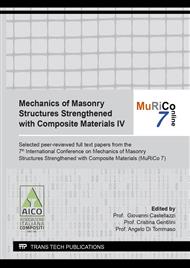p.249
p.256
p.267
p.275
p.283
p.289
p.297
p.305
p.313
Experimental Investigation on the Bond Behaviour of Masonry Element Strengthened with Carbon-TRM and Steel-TRM
Abstract:
Textile reinforced mortar (TRM) composites are an innovative solution for strengthening existing structures. TRM composites are produced with high-strength textile embedded in inorganic mortar matrices, demonstrating compatibility with existing masonry. As TRM is externally bonded to the surface of the structure, the bond behaviour between TRM and masonry substrate is a critical issue to investigate. In this study, experimental research aims to deeply understand the bond behaviour of TRMs for strengthening masonry structures. The experiments mainly consist of a series of single-lap shear bond tests on TRMs to masonry substrates. Two types of textiles (carbon and steel textile) combined with two mortar matrices (cement and lime-based mortar) were used to construct TRM. The effect of the textile and mortar matrix is presented. The test results are discussed in terms of the full range of load-slip responses and failure modes. The result showed that TRM with steel textile and cement-based mortar matrix offers better bond behaviour, but the risk of masonry damage should also be considered.
Info:
Periodical:
Pages:
283-288
Citation:
Online since:
April 2022
Authors:
Keywords:
Price:
Сopyright:
© 2022 Trans Tech Publications Ltd. All Rights Reserved
Share:
Citation:


